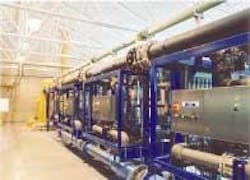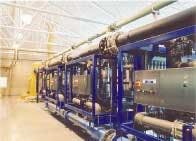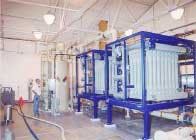Microfiltration Membranes Help Water District Become EPA-Compliant
By Lisa Sorgini
The U.S. Environmental Protection Agency's Surface Water Treatment Rule (SWTR) specifies that all public drinking water supplies must be treated for particulates and microbiological contaminants such as Cryptosporidium and Giardia lamblia, without endangering proximate ecosystems.
In the late 1990s, the Carmichael Water District, a publicly owned and operated agency serving approximately 37,000 residents in Sacramento County, CA, realized it was out of compliance with the rule. As a result, the district needed to find a treatment method that reduced the risk of adverse public health effects but still ensured the environmental well-being of the nearby American River. The adopted method also needed to meet with public approval.
"Our community was very active in the project right from the start, and even participated in the final site selection and building design," said Steve Nugent, assistant general manager of the Carmichael Water District.
With the help of a community advisory group and local design engineer Montgomery Watson Harza, the district evaluated conventional and non-conventional filtration methods, ultimately selecting USFilter's Memcor® continuous microfiltration (CMF) technology for installation at its Bajamont Way Water Treatment Plant (WTP). The district based its decision on a successful pilot study and Montgomery Watson's longtime partnership with the membrane supplier, as well as the manufacturer's equipment costs, full-scale experience, backwash recovery system and integrity testing.
The CMF system at Bajamont Way is fully automated. Source water from the American River is collected in Ranney wells that act as infiltration galleries in the riverbed. The raw water then passes through the system's 1,080 membrane modules, each containing 20,000 hollow fibers. With an average pore size of 0.2 microns, the membranes filter out particulates and protozoa, as well as most suspended solids.
The CMF system's automated and sensitive integrity test system allows operators to directly verify over 4-log reduction of pathogenic organisms such as Cryptosporidium and Giardia lamblia, easily meeting existing and future drinking water regulations for removal. The plant consistently delivers water with turbidity of less than 0.05 nephelometric turbidity units (NTU).
The Memcor® CMF system consists of 12 units for primary filtration, containing 90 modules each. The facility has an average flow of 9 mgd and a total peak capacity of 17 mgd. To maintain uninterrupted operation, the system was designed to have 11 units online at the design flow and one unit in stand-by for offline chemical cleaning.
To reduce cost of waste disposal, backwash water from the primary filtration system passes through two skids having a total of 96 additional membrane modules. This secondary stage was designed to recover up to 90 percent of the backwash water produced during normal filtration. These units treat up to 600,000 gpd of filter backwash water, enabling the plant to process more than 99 percent of its water supply into potable water.
Currently, the filtrate water from the secondary stage is sent back to the head of the plant as required by the California Department of Health Services. Backwash waste from the secondary stage will soon be sent through a third stage of CMF units, increasing the overall plant recovery to 99.96 percent.
According to Nugent, the district is pleased with how the Memcor® CMF system is operating.
"In just one year, our water quality complaints went from more than 700 a year to fewer than 70 a year," he said.
In addition to improving water quality, the CMF system has also provided labor savings. Whereas the district used to spend thousands of hours per year flushing water mains to remove sediment from the distribution system, it has now been able to reduce its flushing program by 80 percent.
"This has saved the district well over $100,000 annually," Nugent said.
Additionally, the CMF system's membrane integrity monitoring and minimum mechanical maintenance help keep operating costs low.
USFilter has installed more than 80 Memcor® CMF systems throughout the western United States with a capacity exceeding 100 mgd. On a larger scale, more than 700 Memcor® CMF systems are currently in operation worldwide.
About the Author Lisa Sorgini is USFilter's Memcor product specialist for the western United States and Canada. Her responsibilities include developing, monitoring and sizing potential microfiltration and reverse osmosis systems for municipal water and wastewater applications. Prior to joining USFilter, Lisa was a consulting engineer in Cambridge, MA. Lisa earned her bachelors degree with distinction in Civil Engineering at the Worcester Polytechnic Institute in Worcester, MA.


